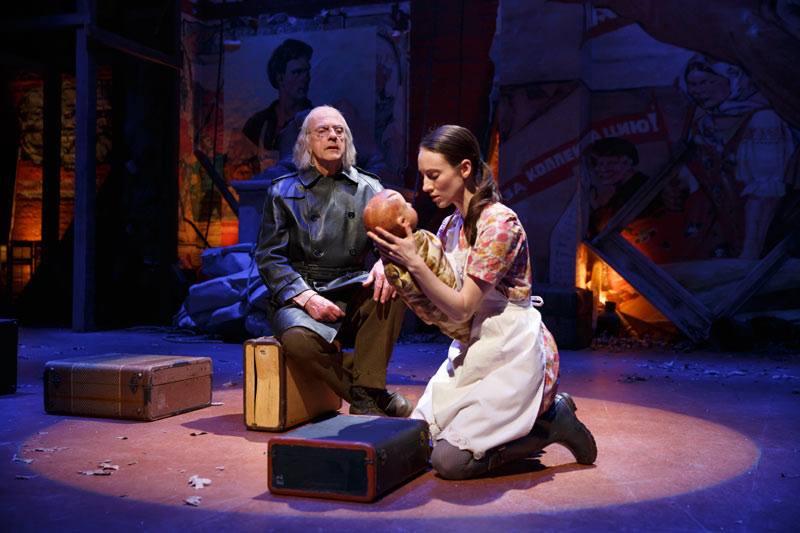In today’s Wall Street Journal I review two major revivals in New York and Chicago, Classic Stage Company’s The Caucasian Chalk Circle and the Court Theatre’s The Misanthrope. Both are superior. Here’s an excerpt.
* * *
Bertolt Brecht was a bad man who was also a great artist, and the play in which it is most difficult to attend exclusively to his greatness is “The Caucasian Chalk Circle.” First produced in East Berlin in 1954, “The Caucasian Chalk Circle” is a complex and mysterous fable of justice and its discontents that is prefaced by a strident prologue set on a collective farm in which Brecht, who was famously enamored of Soviet Communism, assures the audience that “the home of the Soviet people shall also be the home of Reason!” How can those who know of Stalin’s murderous proclivities bridge the gap between propaganda and parable? Should we even try?
 Brian Kulick has “solved” this problem cleverly–if evasively–in Classic Stage Company’s revival of “The Caucasian Chalk Circle.” Not only has he cut the prologue, but he’s moved the action forward to 1989, immediately after the collapse of Communism. The premise of the production is that “The Caucasian Chalk Circle” is being performed by a poverty-stricken troupe of strolling players who now realize that the result of the Russian Revolution was “to make it possible for the most evil people to have the most power.” While this confession, presumably penned by Mr. Kulick himself, is spoken not in English but in untranslated Russian, it’s plain to see what’s going on, since the centerpiece of Tony Straiges’ set is a statue of Lenin that is pulled off its pedestal and smashed to bits as the show gets underway.
Brian Kulick has “solved” this problem cleverly–if evasively–in Classic Stage Company’s revival of “The Caucasian Chalk Circle.” Not only has he cut the prologue, but he’s moved the action forward to 1989, immediately after the collapse of Communism. The premise of the production is that “The Caucasian Chalk Circle” is being performed by a poverty-stricken troupe of strolling players who now realize that the result of the Russian Revolution was “to make it possible for the most evil people to have the most power.” While this confession, presumably penned by Mr. Kulick himself, is spoken not in English but in untranslated Russian, it’s plain to see what’s going on, since the centerpiece of Tony Straiges’ set is a statue of Lenin that is pulled off its pedestal and smashed to bits as the show gets underway.
What follows is a straightforward yet sensitive rendering of “The Caucasian Chalk Circle” that is enacted with lively simplicity…
Nobody needs to make a case for “The Misanthrope,” but Charles Newell, artistic director of the Court Theatre, has done something equally ingenious with Molière’s satirical masterpiece: He’s come up with a high-concept production devoid of the this-means-that rigidity that is too often the curse of such updated versions.
In Mr. Newell’s staging of Richard Wilbur’s immaculately lucid verse translation of “The Misanthrope,” virtually all of the characters save for Alceste (Erik Hellman), the reflexively tactless anti-hero, are played by black or biracial actors. I doubt I need to tell you how that could have worked out in practice, but Mr. Newell has developed his defining idea in a way that is not schematic but supple. Instead of banging the audience over the head with the obvious fact that Alceste is white, Mr. Newell offers it up as a given and lets us decide for ourselves what it means. Is Alceste a traditionalist at sea in the disorienting world of modernity? That’s my reading, but nothing about Mr. Newell’s staging demands that you agree with me–or, indeed, draw any definitive conclusion as to what he has in mind–and the ambiguity that results is not indecisive but stimulating….
* * *
Read the whole thing here.
A scene from the Court Theatre’s production of The Misanthrope:
Terry Teachout on the arts in New York City
